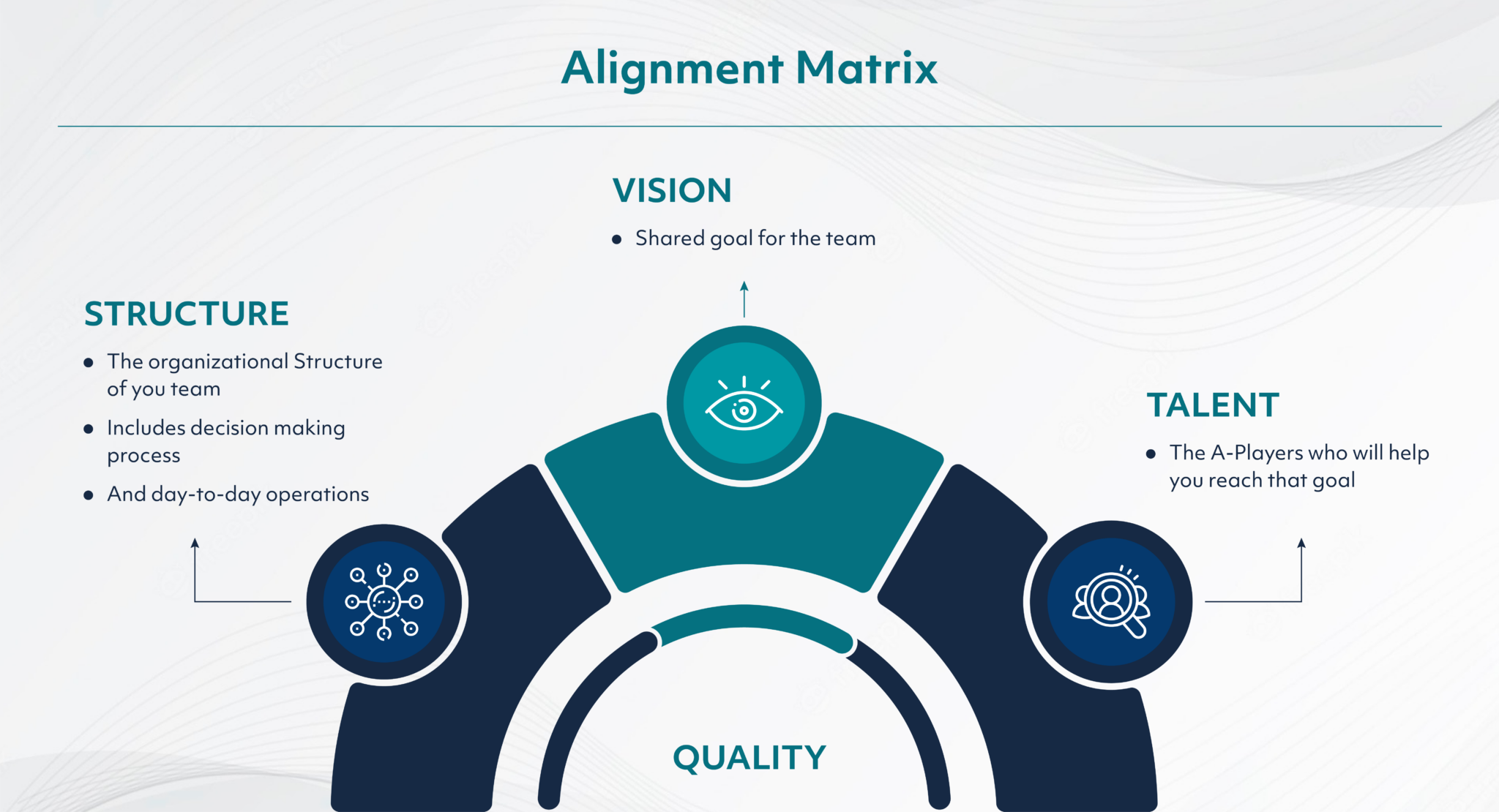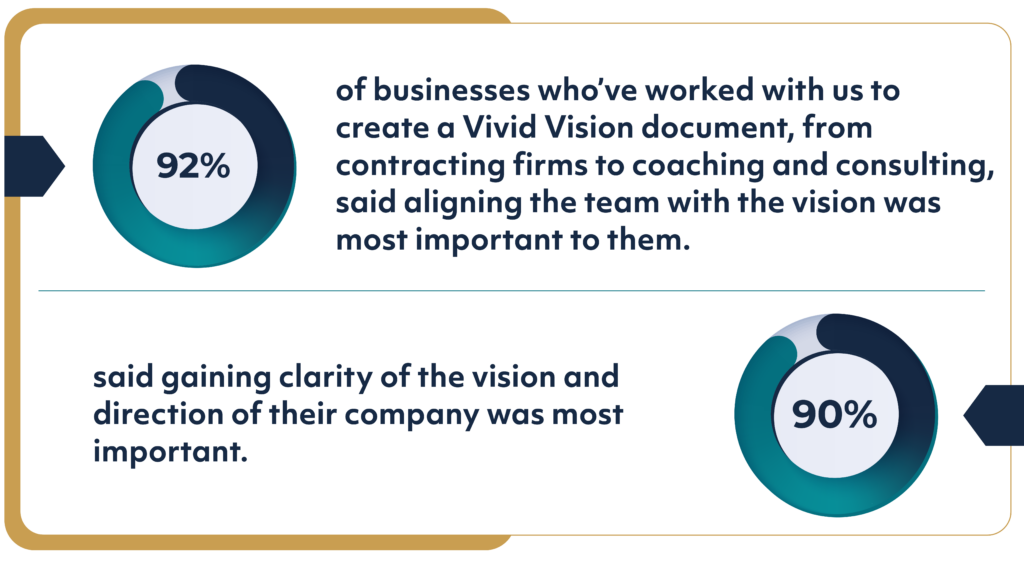Copyright © 2023 Conscious Copy & Co. All Right Reserved. | Terms & Conditions | Privacy Policy | Innovated by
Table Of Contents:
Team alignment can be loosely defined as “a coordinated effort between team members to achieve a common goal.” Or, in simple terms, team alignment is when team members are on the same page.
A team that’s aligned rallies together towards the same vision, and is made up of team members who are inspired to execute on the strategic objectives needed to turn that vision into a reality.
From the Harvard Business Review:
This is what enterprise alignment looks like. It means winning through a tightly managed enterprise value chain that connects an enterprise’s purpose (what we do and why we do it) to its business strategy (what we are trying to win at to fulfill our purpose), organizational capability (what we need to be good at to win), resource architecture (what makes us good), and, finally, management systems (what delivers the winning performance we need).
Team alignment can be loosely defined as “a coordinated effort between team members to achieve a common goal.” Or, in simple terms, team alignment is when team members are on the same page.
A team that’s aligned rallies together towards the same vision, and is made up of team members who are inspired to execute on the strategic objectives needed to turn that vision into a reality.
From the Harvard Business Review:
This is what enterprise alignment looks like. It means winning through a tightly managed enterprise value chain that connects an enterprise’s purpose (what we do and why we do it) to its business strategy (what we are trying to win at to fulfill our purpose), organizational capability (what we need to be good at to win), resource architecture (what makes us good), and, finally, management systems (what delivers the winning performance we need).
If you’re a business owner or CEO, you know what it’s like to have a team that’s not on the same page. Constant breakdowns and confusion can keep you from hitting your goals. Whether you want to scale your production line, hit company KPIs, or weekly sales goals, team alignment is critical to build a strong organization that propels you forward instead of holding you back.
A study we conducted at Conscious Copy & Co., after helping 400+ businesses create their Vivid Vision, showed that:
So it’s no surprise that effective ways to motivate and align a team is one of the most searched for terms when it comes to leadership strategies, because it connects the efforts of the team to a higher purpose. And the science shows that members of an organization who understand the significance of their contributions are more motivated and productive:

Source: https://www.re-work.co/
If you’re a business owner or CEO, you know what it’s like to have a team that’s not on the same page. Constant breakdowns and confusion can keep you from hitting your goals. Whether you want to scale your production line, hit company KPIs, or weekly sales goals, team alignment is critical to build a strong organization that propels you forward instead of holding you back.
A study we conducted at Conscious Copy & Co., after helping 400+ businesses create their Vivid Vision, showed that:
So it’s no surprise that effective ways to motivate and align a team is one of the most searched for terms when it comes to leadership strategies, because it connects the efforts of the team to a higher purpose. And the science shows that members of an organization who understand the significance of their contributions are more motivated and productive:

The first step is to define what type of team you have. Then, focus on each area of your Team Alignment Triad to strengthen your team’s ability to execute (more on that in a moment).
Functional Teams are most commonly known as “departments.” They are groups of people who work together to accomplish a goal. For example, an HR department within a large organization is its own functional team, as is accounting or finance. A functional team is like its own little ecosystem. Having each department aligned with each other is crucial to the results they produce, and pushing the whole business forward towards the big vision of the company.
Cross-Functional Teams are a select group of people assembled from other functional teams or departments, who collaborate to achieve common goals just like any other team. This allows the company to produce certain results faster and more efficiently, since projects that need multi-departmental input/collaboration don’t simply move from one department to the next—each department is involved throughout the entire process. Cross-functional teams can also spark innovation. When other departments apply expertise to new areas of focus, they provide different viewpoints and systems for development. Meaning cross-team collaboration makes for much more creative solutions, which is why alignment across these teams is important.
Self-Managed Teams are a group of employees that operate on their own, with little to no management or supervision. They monitor and manage their own performance. This is common in the software industry, with companies like Facebook and Google using teams like this to reduce manager workload, increase productivity with less cost, drive innovation, and create agile problem solvers. There’s a lot of nuance when it comes to defining self-managed teams, with some companies creating temporary teams for specific objectives, and others working autonomously as their own department with no top-down supervision, which makes alignment with larger company goals and vision even more important.
Leadership Teams refer to the organization’s upper-level executives, or executive decision makers. They’re responsible for the direction of the company by clarifying the vision, defining the strategy, executing on the short and long term goals, and measuring results to make better decisions for the growth of the business. Corporate leadership is often made up of C-Level executives such as the CEO, COO, CFO, CMO, CTO, etc. The stronger and more aligned the leadership team is, the more aligned the rest of the organization.
Remote & Virtual Teams can be any of the above, except they aren’t tied down to physical location. They meet virtually online. Like all teams, they are made up of members working together to achieve a desired outcome. Teams like these have become more common since 2020, along with what are referred to as “hybrid teams,” which consist of members that are both remote and bound by location, but many businesses have been using them for years. Conscious Copy & Co., for example, has been an entirely virtual team since our founding in 2017! While there are a ton of great benefits that come with virtual and hybrid teams, challenges in communication, team culture, and other important areas can be troublesome and hurt productivity. The right systems must be in place to achieve team alignment and success.
Experts and leaders across dozens of industries, from small organizations to large corporations all agree that team alignment depends on three core areas: vision, talent, and structure. In other words, what is the shared vision for your team to hold, who are the people in place to make it happen, and how are they set up for success? This makes up what we call: The Alignment Triad.

SOURCE: Conscious Copy
To determine the most effective leadership strategies for team alignment, we applied The Alignment Triad model to each type of team featured in this library.
What is the vision you have for your team? A study done by PwC of global businesses showed that:

All this adds up to a crisis of purpose: Workers feel lost. And over time, a lack of direction saps motivation; people begin backing away from the challenges required to achieve the firm’s articulated goals.
Not only that, but leaders lack clarity:
92% of businesses who’ve worked with us to create a Vivid Vision document, from contracting firms to coaching and consulting, said aligning the team with the vision was most important to them.
And 90% said gaining clarity of the vision and direction of their company was most important.

SOURCE: Conscious Copy
Which is why your goals should be defined after your vision is clear.

SOURCE: https://www.sciencedirect.com
KPIs and clear outcomes are important to your team’s success, but if you want to motivate and inspire your team to hit them, they need to understand the bigger vision.
Who are the right people needed to bring your vision to life? A team is only as strong as its people. To execute on your vision, you need the right people in the right positions. And you must be able to keep them there.
McKinsey reported that while millions of people have quit their jobs in the last few years in what experts have called the Great Resignation, the most productive companies coming out of the 2020 pandemic improved job satisfaction by 48%.

Attracting, developing, and empowering the right people will increase your company performance, but they must be aligned with the vision, each other, and given the proper tools to succeed.
What structures are in place for your talent to execute? If you’ve clearly communicated your vision and the direction for your company, and have a dedicated team assembled to turn it into a reality, their success will rely heavily on the structures you have in place. How your team is organized and managed will affect the output, how they communicate, and how they make decisions.
The more organized your structure, the more productive the team.
The first step is to define what type of team you have. Then, focus on each area of your Team Alignment Triad to strengthen your team’s ability to execute (more on that in a moment).
Functional Teams are most commonly known as “departments.” They are groups of people who work together to accomplish a goal. For example, an HR department within a large organization is its own functional team, as is accounting or finance. A functional team is like its own little ecosystem. Having each department aligned with each other is crucial to the results they produce, and pushing the whole business forward towards the big vision of the company.
Cross-Functional Teams are a select group of people assembled from other functional teams or departments, who collaborate to achieve common goals just like any other team. This allows the company to produce certain results faster and more efficiently, since projects that need multi-departmental input/collaboration don’t simply move from one department to the next—each department is involved throughout the entire process. Cross-functional teams can also spark innovation. When other departments apply expertise to new areas of focus, they provide different viewpoints and systems for development. Meaning cross-team collaboration makes for much more creative solutions, which is why alignment across these teams is important.
Self-Managed Teams are a group of employees that operate on their own, with little to no management or supervision. They monitor and manage their own performance. This is common in the software industry, with companies like Facebook and Google using teams like this to reduce manager workload, increase productivity with less cost, drive innovation, and create agile problem solvers. There’s a lot of nuance when it comes to defining self-managed teams, with some companies creating temporary teams for specific objectives, and others working autonomously as their own department with no top-down supervision, which makes alignment with larger company goals and vision even more important.
Leadership Teams refer to the organization’s upper-level executives, or executive decision makers. They’re responsible for the direction of the company by clarifying the vision, defining the strategy, executing on the short and long term goals, and measuring results to make better decisions for the growth of the business. Corporate leadership is often made up of C-Level executives such as the CEO, COO, CFO, CMO, CTO, etc. The stronger and more aligned the leadership team is, the more aligned the rest of the organization.
Remote & Virtual Teams can be any of the above, except they aren’t tied down to physical location. They meet virtually online. Like all teams, they are made up of members working together to achieve a desired outcome. Teams like these have become more common since 2020, along with what are referred to as “hybrid teams,” which consist of members that are both remote and bound by location, but many businesses have been using them for years. Conscious Copy & Co., for example, has been an entirely virtual team since our founding in 2017! While there are a ton of great benefits that come with virtual and hybrid teams, challenges in communication, team culture, and other important areas can be troublesome and hurt productivity. The right systems must be in place to achieve team alignment and success.
The Alignment Triad: Vision, Talent, and Structure
Experts and leaders across dozens of industries, from small organizations to large corporations all agree that team alignment depends on three core areas: vision, talent, and structure. In other words, what is the shared vision for your team to hold, who are the people in place to make it happen, and how are they set up for success? This makes up what we call: The Alignment Triad.

SOURCE: Conscious Copy
To determine the most effective leadership strategies for team alignment, we applied The Alignment Triad model to each type of team featured in this library.
What is the vision you have for your team? A study done by PwC of global businesses showed that:

All this adds up to a crisis of purpose: Workers feel lost. And over time, a lack of direction saps motivation; people begin backing away from the challenges required to achieve the firm’s articulated goals.
Not only that, but leaders lack clarity:
92% of businesses who’ve worked with us to create a Vivid Vision document, from contracting firms to coaching and consulting, said aligning the team with the vision was most important to them.
And 90% said gaining clarity of the vision and direction of their company was most important.

SOURCE: Conscious Copy
Which is why your goals should be defined after your vision is clear.

SOURCE:https://www.sciencedirect.com/science/article/abs/pii/S0749597806000641
KPIs and clear outcomes are important to your team’s success, but if you want to motivate and inspire your team to hit them, they need to understand the bigger vision.
Who are the right people needed to bring your vision to life? A team is only as strong as its people. To execute on your vision, you need the right people in the right positions. And you must be able to keep them there.
McKinsey reported that while millions of people have quit their jobs in the last few years in what experts have called the Great Resignation, the most productive companies coming out of the 2020 pandemic improved job satisfaction by 48%.

Attracting, developing, and empowering the right people will increase your company performance, but they must be aligned with the vision, each other, and given the proper tools to succeed.
What structures are in place for your talent to execute? If you’ve clearly communicated your vision and the direction for your company, and have a dedicated team assembled to turn it into a reality, their success will rely heavily on the structures you have in place. How your team is organized and managed will affect the output, how they communicate, and how they make decisions.
The more organized your structure, the more productive the team.
Copyright © 2023 Conscious Copy & Co. All Right Reserved. | Terms & Conditions | Privacy Policy | Innovated by